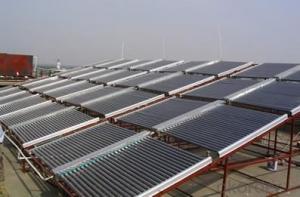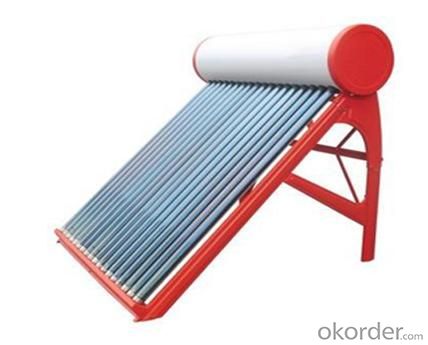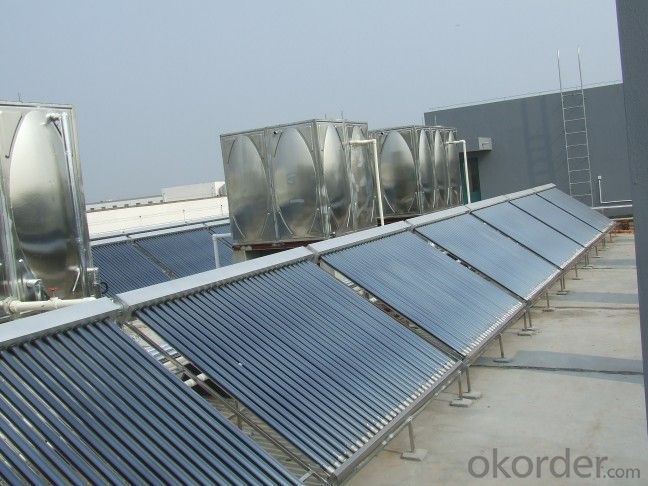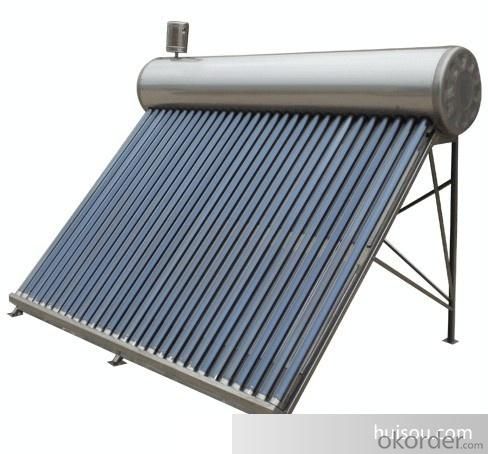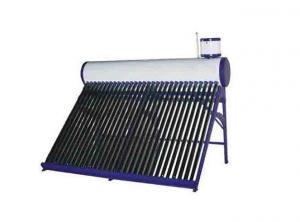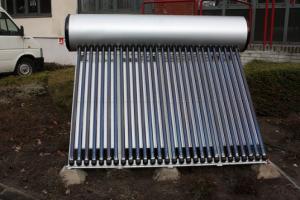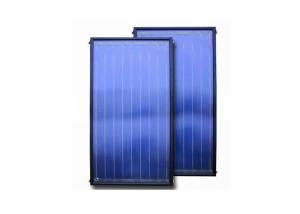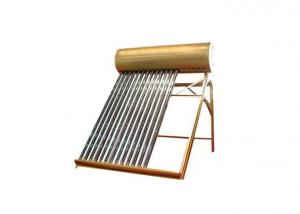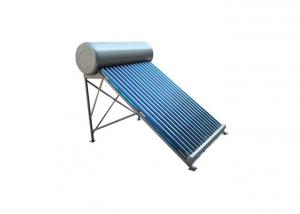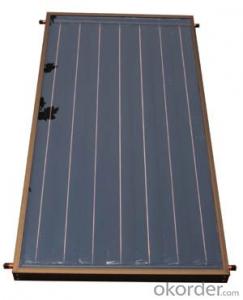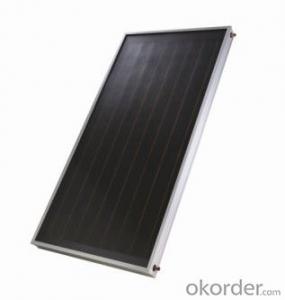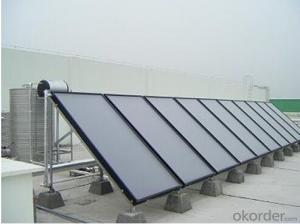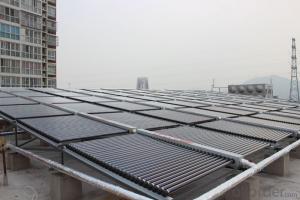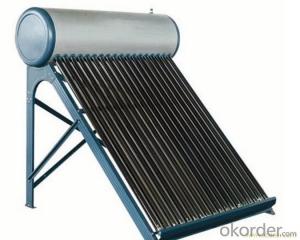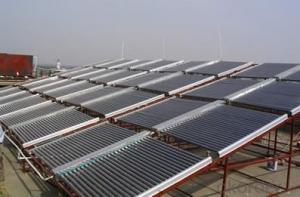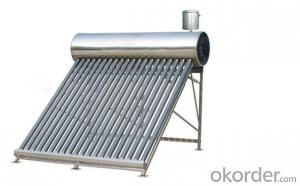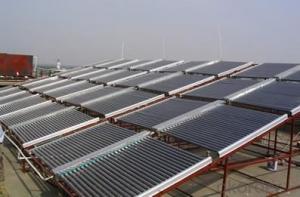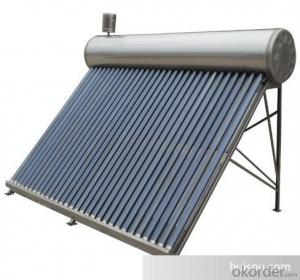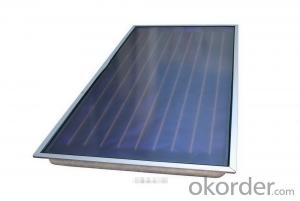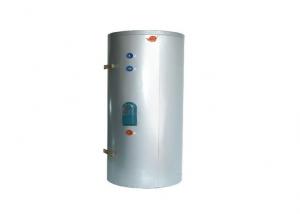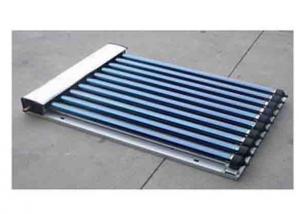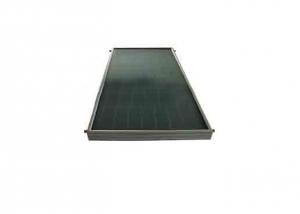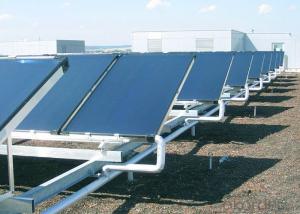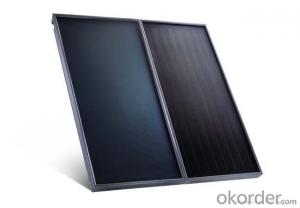Vacuum Solar Collectors Non-Pressurized Heat Pipe Solar Water Heater System 2024 New Design
- Loading Port:
- China main port
- Payment Terms:
- TT OR LC
- Min Order Qty:
- 1 set
- Supply Capability:
- 6000 set/month
OKorder Service Pledge
OKorder Financial Service
You Might Also Like
Introduction of Non-Pressure Solar Water Heater:
Non-pressure Solar Heater is one of the most economical solar water heating device with pretty high efficiency at the same time. It consists of hot water storage tank, solar vacuum tubes with mouth plug in storage tank, and bracket supporting tank and tubes.When cold water in evacuated tubes is heated with solar irradiation, as the specific gravities of hot water and cold water are different, hotter water goes upward to storage tank and colder water goes downward to glass tubes. through this continuous circulation, the cold water in storage tank will be gradually heated till sunset.
Specialty:
1. High thermal performance and working temperature: the heat exchanging rate even in winter can up above 55%.
2. Heat collecting efficiency is at least 20% above common solar systems.
3. Work in all day and all season: no matter any corner of the world, this system can work well even -40℃ to avoid the tube freezing problem.
4. Reliability: No water following through the tube, so water scale can not generate and tube cracks could be avoided, the system still can keep working even with some damaged tubes.
5. It can connect with water tap and work automatically with pressure0.6Mpa, bring enjoyable washing experience.
6. Safety: P/T valve would release pressure and temperature to protect tank..
Technical Specification:
1. Outer tank material: SUS304 stainless steel or powder coated color steel
2. Inner tank material: 1.2mm thick SUS304 food grade stainless steel ( Optional material SUS316L)
3. Vacuum tube material: borosilicate glass 3.3; AL-SS-CU absorb coating, with copper heat pipe inside
4. Frame material: 1.2mm thickness stainless steel
5. Insulation material: 55mm thickness polyurethane
6. Suitable for mains pressure water(up to 8 bar/116psi)
7. Easy plug-in installation
8. Install the T/P valve on the pressurized tank
9. Seal material: Stabilized High Temperature Silicon
Outer tank material: SUS304 stainless steel or powder coated color steel
Inner tank material: 1.2mm thick SUS304 food grade stainless steel ( Optional material SUS316L)
Vacuum tube material: borosilicate glass 3.3; AL-SS-CU absorb coating, with copper heat pipe inside
Frame material: 1.2mm thickness stainless steel
Insulation material: 55mm thickness polyurethane
Suitable for mains pressure water(up to 8 bar/116psi)
Easy plug-in installation
Install the T/P valve on the pressurized tank
Seal material: Stabilized High Temperature Silicon
19. Vacuum Tube | 20. Size (mm) | 21. Φ47*1500 / Φ58*1800 / Φ70*2100 | |||||
22. Tube (pcs) | 23. 10 / 12 / 15 / 18 / 20 / 22 / 24 / 30 / 36 / 42 | ||||||
24. Material | 25. Borosilicate 3.3 glass, magnetron spluttering selective coating | ||||||
26. Coating | 27. Single-target AL-N/AL or Three-target AL/N-Cu-SS | ||||||
28. Water Tank | 29. Capacity | 30. 80L ~ 500L for hot water storage tank | |||||
31. Inner tank | 32. Food-grade stainless steel SUS304-2B / SUS316 | ||||||
33. Insulation | 34. High-density polyurethane foam with 70~80 hour heat preservation | ||||||
35. Tank shell | 36. Food-grade stainless steel SUS304-2B | ||||||
37. Bracket | 38. Shaped strong aluminum alloy structure adaptable for flat or slope roof | ||||||
39. Accessories | 40. Anti-aging silicon seals, Dustproof seals, Air-vent cap, Stainless screws | ||||||
41. Auxiliary Devices | 42. Assistant tank, Intelligent controller, Electrical heater, Magnesium anodes | ||||||
43. Tilt Angle | 44. 25 ~ 50° | ||||||
45. Water Output | 46. 45 - 95°C | ||||||
47. Hail Resistance | 48. Φ25mm diameter | ||||||
49. Model Number | 50. Solar Vacuum Tube | 51. Tank 52. Liter | 53. System 54. Liter | 55. Container Loading Qty /sets | |||
56. Size /mm | 57. Qty /pcs | 58. 20GP | 59. 40GP | 60. 40HQ | |||
61. VNS-58SA12-100 | 62. Φ58*1800 | 63. 12 | 64. 100 | 65. 132 | 66. 58 | 67. 119 | 68. 140 |
69. VNS-58SA15-130 | 70. 15 | 71. 130 | 72. 170 | 73. 54 | 74. 108 | 75. 131 | |
76. VNS-58SA18-150 | 77. 18 | 78. 150 | 79. 198 | 80. 43 | 81. 86 | 82. 105 | |
83. VNS-58SA20-170 | 84. 20 | 85. 170 | 86. 223 | 87. 40 | 88. 80 | 89. 97 | |
VNS-58SA24-200 | 24 | 200 | 263 | 35 | 70 | 85 | |
VNS-58SA30-250 | 30 | 250 | 329 | 28 | 56 | 68 | |
VNS-58SA36-300 | 36 | 300 | 395 | 23 | 47 | 57 | |
Product Show
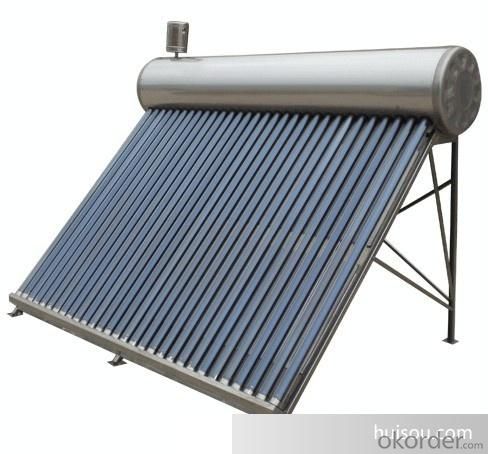
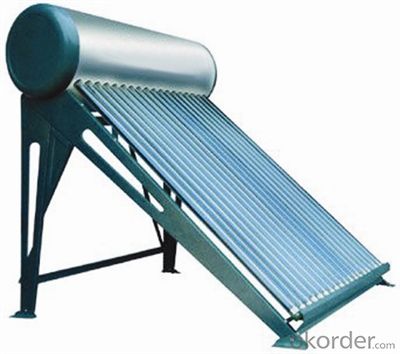
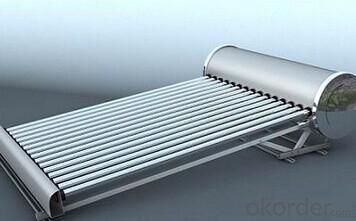
Our Services
1. OEM service
2. Warranty: 5 years
3. Considerable after sale service
Color steel Compact pressure Thermal solar heater
FAQ:
1. What’s the delivery time?
10 days after receiving deposit.
2. How long is the warranty?
5 years for whole system, 1 year for accessory
3. What’s your production capacity?
6000sets/month
4. What’s the MOQ?
1 set.
5. What’s your payment term?
Container: 30% T/T in advance for deposit, 70% T/T before shipment for fist order.
70% T/T after seeing copy of B/L from second order
Sample: 100% T/T in advance
Other choices: L/C at sight.
6. What certifications do you have?
CE, SOLAR KEYMARK, SRCC and etc.
- Q: Can solar collectors be integrated into existing buildings?
- Yes, solar collectors can be integrated into existing buildings through various methods such as rooftop installations, solar facades, or even solar windows. Retrofitting existing buildings with solar collectors allows for the harnessing of solar energy without the need for major structural changes or rebuilding.
- Q: Are solar collectors suitable for hospitals and healthcare facilities?
- Yes, solar collectors are suitable for hospitals and healthcare facilities. They provide a sustainable and cost-effective source of energy for various operations, including heating water, powering equipment, and generating electricity. By utilizing solar energy, healthcare facilities can reduce their carbon footprint, lower energy costs, and contribute to a healthier environment. Additionally, solar collectors can help ensure a reliable energy supply during power outages, which is crucial for maintaining critical medical services.
- Q: How do solar collectors affect wildlife?
- The effects of solar collectors, such as solar panels or solar thermal systems, on wildlife can be both positive and negative. On one hand, solar collectors play a crucial role in reducing greenhouse gas emissions and combating climate change, which is vital for the preservation of biodiversity and wildlife habitats in the long term. By replacing energy sources that rely on fossil fuels, solar collectors help to decrease air and water pollution, which can have detrimental impacts on wildlife populations. In addition, solar collectors have a smaller physical footprint compared to other methods of energy production, such as coal-fired power plants or hydroelectric dams. This means they take up less land and do not require extensive infrastructure development, which can disrupt habitats and lead to the displacement or extinction of certain species. From this perspective, solar collectors can be seen as a more environmentally friendly option for generating energy. However, it is important to acknowledge that solar collectors can also have negative effects on wildlife. For example, large-scale solar farms can alter the natural landscape, resulting in the loss of habitat for certain species. This disruption can interfere with migration patterns, breeding behaviors, and feeding habits, ultimately affecting the overall balance of the ecosystem. Furthermore, the construction and maintenance of solar collectors can cause noise and light pollution, disturbing wildlife and potentially impacting their behavior and ability to reproduce. To address these negative impacts, careful planning and site selection for solar collector installations are crucial. Environmental assessments should be conducted to identify potential risks to wildlife and their habitats. Measures such as minimizing disturbance to natural environments, restoring or creating new habitats, and adopting designs that are wildlife-friendly can be implemented to reduce the impact of solar collectors on wildlife. In summary, while solar collectors have the potential to positively contribute to wildlife conservation by reducing greenhouse gas emissions and pollution, it is important to carefully consider and manage their effects on wildlife habitats and populations.
- Q: Can solar collectors be used in combination with solar tracking systems?
- Solar collectors can be utilized alongside solar tracking systems to increase the efficiency and output of a solar energy system. These collectors are specifically designed to capture and convert sunlight into usable energy, while solar tracking systems adjust the position of the solar panels or collectors throughout the day to maximize sunlight absorption. By combining these technologies, the overall performance of the solar energy system can be significantly improved. Solar tracking systems function by following the movement of the sun and adjusting the angle and orientation of the solar collectors accordingly. This ensures that the collectors capture sunlight at the optimal angle, resulting in the highest possible energy generation. The ability to track the sun throughout the day guarantees that the solar collectors are always positioned to receive the maximum amount of sunlight available. When used in conjunction with solar tracking systems, solar collectors enhance the overall functionality of a solar energy system. They can be employed in various applications, such as solar thermal collectors for heating water or air, or photovoltaic (PV) panels for electricity generation. By incorporating both solar collectors and solar tracking systems, the energy output of the system can be increased, leading to improved efficiency and cost-effectiveness. Nevertheless, it is important to consider that implementing solar tracking systems may entail additional costs and maintenance requirements. The moving parts and mechanisms involved in tracking the sun's movement need to be carefully maintained to ensure proper functioning. Furthermore, the enhanced efficiency provided by solar tracking systems may not always justify the additional investment, particularly in areas with consistently high solar irradiance. In conclusion, solar collectors can be effectively combined with solar tracking systems to optimize the efficiency and energy output of a solar energy system. However, the decision to integrate solar tracking should be carefully evaluated based on the specific requirements, location, and cost-effectiveness of the project.
- Q: Can solar collectors be used for heating residential neighborhoods?
- Yes, solar collectors can be used for heating residential neighborhoods. Solar collectors, such as solar thermal systems or solar water heaters, can capture the sun's energy to heat water or air, which can then be distributed throughout a residential neighborhood for space heating purposes. This renewable energy source can help reduce reliance on fossil fuels and lower carbon emissions, making it a sustainable and environmentally friendly option for heating residential areas.
- Q: How do solar collectors compare to solar panels?
- Solar collectors and solar panels serve different purposes in harnessing solar energy. Solar collectors are primarily used for heating water or air, while solar panels are designed to convert sunlight into electricity. Solar collectors are more efficient in capturing and utilizing solar energy for heating purposes, as they are specifically designed for this function. On the other hand, solar panels are more commonly utilized for generating electricity, making them more suitable for powering homes or other electrical devices. Ultimately, the choice between solar collectors and solar panels depends on the intended use and energy requirements of the specific application.
- Q: Can solar collectors be used in conjunction with other renewable energy sources?
- Yes, solar collectors can definitely be used in conjunction with other renewable energy sources. In fact, combining different renewable energy sources can enhance overall energy production and ensure a more reliable and consistent power supply. For example, solar collectors can be paired with wind turbines or hydroelectric systems to create a hybrid renewable energy system. This approach allows for optimal utilization of resources, as solar energy can be harnessed during the day while wind or water power can be utilized during periods of low solar radiation. By diversifying the energy mix, we can maximize efficiency and reduce dependency on non-renewable sources.
- Q: How do solar collectors compare to other sources of renewable energy?
- Solar collectors are a highly efficient and reliable source of renewable energy. Unlike other sources such as wind or hydroelectric power, solar collectors can be installed almost anywhere and are not dependent on specific geographical conditions. Additionally, solar collectors have a longer lifespan and require less maintenance, making them a cost-effective option for generating clean energy.
- Q: Can solar collectors be used in cloudy weather?
- Yes, solar collectors can still be used in cloudy weather. Although the efficiency of solar collectors may decrease in overcast conditions, they can still generate some amount of electricity or heat from the available sunlight.
- Q: Can solar collectors be used in both residential and commercial applications?
- Yes, solar collectors can be used in both residential and commercial applications. They are versatile and can be installed on rooftops, facades, or ground-mounted systems in homes, businesses, and large commercial buildings alike.
Send your message to us
Vacuum Solar Collectors Non-Pressurized Heat Pipe Solar Water Heater System 2024 New Design
- Loading Port:
- China main port
- Payment Terms:
- TT OR LC
- Min Order Qty:
- 1 set
- Supply Capability:
- 6000 set/month
OKorder Service Pledge
OKorder Financial Service
Similar products
Hot products
Hot Searches
Related keywords
